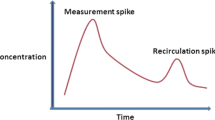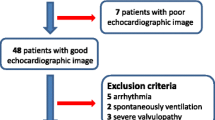Abstract
Clinical parameters alone have repeatedly been proven unreliable in assessing cardiopulmonary status, especially in hemodynamically unstable patients. To learn if we had a diagnostic problem in our hospital, we compared physician assessment of cardiac index (CI) and thoracic fluid content (TFC) to values obtained using impedance cardiography (ICG). We selected the newest available ICG monitor, the BioZ, which employs this noninvasive technology. For CI measurements we have shown it to be equivalent to thermodilution and to be more reproducible (variability: 6.3% vs. 24.7%). Physician assessment of CI and TFC (high, normal, or low) was compared to the BioZ monitor’s results in 186 patients, considered to be hemodynamically unstable, from the emergency room, the intensive care units, and the floors. Normal values were defined for CI (2.5–4.2 L/min m2) and for TFC (males: 30–50 kohm−1 and females: 21–37 kohm−1). The concordance between physician assessment and the BioZ was 51% for CI with Kappa of 0.14 and 58% for TFC with Kappa of 0.19. Attendings did slightly better than the surgical residents with CI (52% vs. 48%) but slightly worse with TFC (57% vs. 61%). The potentially serious conditions of low CI and high TFC were misdiagnosed 42% and 46% of the time, respectively, by all physicians. Analysis of the data revealed that physician use of clinically available objective hemodynamic data, such as heart rate, blood pressure, and pulse pressure index, would not have been helpful. Furthermore, assistance from the pulmonary artery catheter (PAC) is often not available in our hospital, which has experienced a 90% decrease in its utilization over the past six years. Considering the increasing acuity of our aging patient population, accurate assessment of cardiopulmonary status is needed. The use of ICG could be a valuable addition to the physician’s armamentarium.


Similar content being viewed by others
References
JT Thomas RF Kelly SJ Thomas et al. (2002) ArticleTitleUtility of history, physical examination, electrocardiogram and chest radiograph for differentiating normal from decreased systolic function in patients with heart failure Am. J. Med. 112 437–445 Occurrence Handle11959053
P. Andrew (2003) ArticleTitleDiastolic heart failure demystified Chest 124 744–753 Occurrence Handle12907569
PR Katz GT Grossberg JF Potter et al. (2002) Geriatrics syllabus for specialists American Geriatric Society New York
J. Consensus recommendations (1999) ArticleTitleCardiol . 83 1A–38 Occurrence Handle10072251
InstitutionalAuthorNameAmerican Heart Association (2000) Heart and stroke statistical update The Association Dallas, TX
AP Davie CM Francis L Caruana et al. (1997) ArticleTitleAssessing diagnosis in heart failure: which features are any use? QJM 90 335–339 Occurrence Handle1:STN:280:ByiA2cbnsVM%3D Occurrence Handle9205668
LW Stevenson JK. Perloff (1989) ArticleTitleThe limited reliability of physical signs for estimating hemodynamics in chronic heart failure JAMA 261 884–888 Occurrence Handle1:STN:280:BiaC3M7it1c%3D Occurrence Handle2913385
S Morgan H Smith I Simpson et al. (1999) ArticleTitlePrevalence and clinical characteristics of left ventricular dysfunction among elderly patients in general practice setting: cross sectional survey BMJ 318 368–372 Occurrence Handle1:STN:280:DyaK1M7jt1Sqtg%3D%3D Occurrence Handle9933201
J Remes H Miettinen A Reunanen et al. (1991) ArticleTitleValidity of clinical diagnosis of heart failure in primary health care Eur. Heart J. 12 315–321 Occurrence Handle1:STN:280:By6B2cbosFM%3D Occurrence Handle2040313
JD Sandham RD Hull RF Brant et al. (2003) ArticleTitleA randomized, controlled trial of the use of pulmonary-artery catheters in high-risk surgical patients N. Engl. J. Med. 348 5–14 Occurrence Handle12510037
C Richard J Warszawski N Anguel et al. (2003) ArticleTitleEarly use of the pulmonary artery catheter and outcomes in patients with shock and acute respiratory distress syndrome: a randomized controlled trial JAMA 290 2713–2720 Occurrence Handle1:CAS:528:DC%2BD3sXpsVars74%3D Occurrence Handle14645314
WS Sageman RH Riffenburgh BD. Spiess (2002) ArticleTitleEquivalence of bioimpedance and thermodilution in measuring cardiac index after cardiac surgery J. Cardiothorac. Vasc. Anesth. 16 8–14 Occurrence Handle11854871
NM Albert MD Hail J Li et al. (2003) ArticleTitleEquivalence of bioimpedance and thermodilution in measuring cardiac output and index in patients with advanced, decompensated chronic heart failure hospitalized in critical care J. Am. Coll. Cardiol. 41 211A
JM Water ParticleVan De TW Miller RL Vogel et al. (2003) ArticleTitleImpedance cardiography: the next vital sign technology? Chest 123 2028–2033 Occurrence Handle12796185
JD. Elashof (1999) nQuery Advisory® Version 3.0 User’s Guide Manufacturer’s name Los Angeles, CA
E. Braunwald (2001) Heart Disease: A Textbook of Cardiovascular Medicine EditionNumber6 WB Saunders Co. Philadelphia, PA
InstitutionalAuthorNameBioZcom (2001) Operator’s Manual CardioDynamics Int. Corp. San Diego, CA
A. Alan (1990) Categorical Data Analysis John Wiley New York 318–357
JW. Holcroft (1994) Shock: ICU management DW Wilmore MF Brennan AH Harken (Eds) Scientific American Surgery Scientific American New York 2–2
KW Burchard (2000) Shock PF Lawrence RM Bell MT Dayton (Eds) Essentials of General Surgery EditionNumber3 Lippincott Williams & Wilkins Philadelphia, PA 93–112
JL Vincent JF Dhainaut C Perret et al. (1998) ArticleTitleIs the pulmonary artery catheter misused? A European view Crit. Care Med. 26 1283–1287 Occurrence Handle1:STN:280:DyaK1czjsVCmtQ%3D%3D Occurrence Handle9671382
IT Miller JM Water ParticleVan De EN Milne et al. (1971) ArticleTitleMeasurement of intrathoracic fluid by impedance plethysmography Br. J. Surg. 58 307 Occurrence Handle1:STN:280:CS6C2sbhsFE%3D
JM Water ParticleVan De BE Mount JR Barela et al. (1973) ArticleTitleMonitoring the chest with impedance Chest 64 597–603 Occurrence Handle4750331
JM Water ParticleVan De BE Mount KMD. TFC Chandra (2004) ArticleTitleA new parameter for assessment of wet lungs Chest . .–.
SA Sasse PA Chen CK. Mahutte (1996) ArticleTitleRelationship of changes in cardiac output to changes in heart rate in medical ICU patients Intensive Care Med. 22 409–414 Occurrence Handle1:STN:280:BymA1cbgs1Y%3D Occurrence Handle8796391
Author information
Authors and Affiliations
Corresponding author
Rights and permissions
About this article
Cite this article
Van De Water, J.M., Dalton, M.L., Parish, D.C. et al. Cardiopulmonary Assessment: Is Improvement Needed?. World J. Surg. 29 (Suppl 1), S95–S98 (2005). https://doi.org/10.1007/s00268-004-2073-z
Published:
Issue Date:
DOI: https://doi.org/10.1007/s00268-004-2073-z




